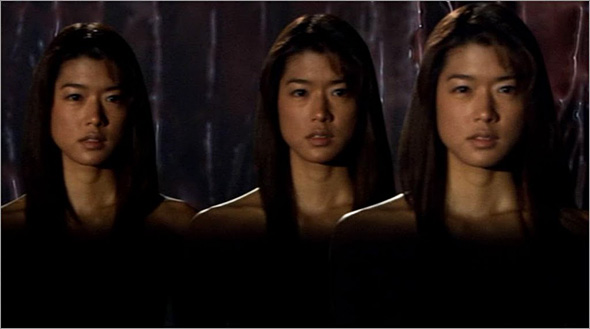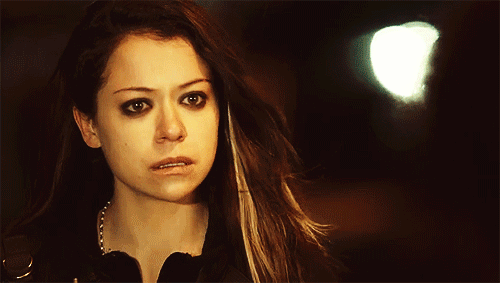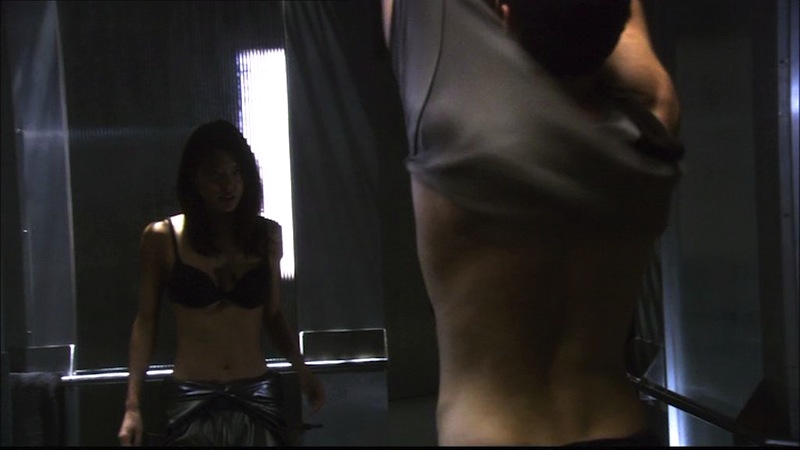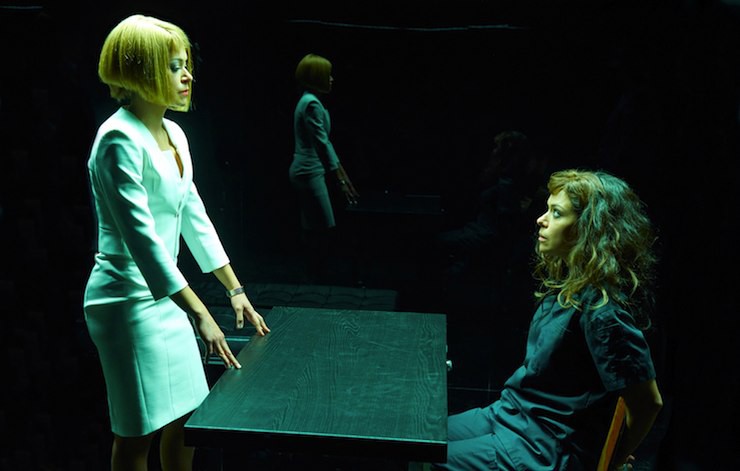Scholars seem to have written off William Shakespeare’s The Comedy of Errors as neither particularly deep nor memorable. It lacks the striking characters (like Hamlet, or Viola) or shocking plot developments (as in Macbeth, or Romeo and Juliet) of other classics. At first glance, its central conflict of mistaken identities seems merely like the kind of sitcom-style plot that could be resolved if everyone just calmed down and said their full names.
And yet, these seemingly comical hijinks represent a deep-seated, universal horror linked to loss of identity. Don’t be fooled: Shakespeare got dark with The Comedy of Errors, introducing the kind of doppelgänger mindfuck story that has been replicated and reimagined through modern SFF TV series like Battlestar Galactica and Orphan Black.
Existential Crisis as Comedy
Like Romeo and Juliet with its Montagues versus Capulets, The Comedy of Errors is all about the deadly rivalry between Syracuse and Ephesus. At the start of the play, Syracusian trader Egeon is sentenced to death for trespassing in Ephesus, but he manages to get a stay of execution when he tells Duke Solinus his tragic tale. Years ago, a shipwreck separated Egeon, his son, and his servant, from Egeon’s wife, who also had a son and servant in tow.
These boys grew up in the two opposing lands, with both parents inexplicably naming both their sons Antipholus, and the servants Dromio. (It’s unclear whether this was a matter of “great minds think alike,” or each parent thought they had Twin #1, which would suck for Twin #2.) When Antipholus and Dromio of Syracuse set out to find their brothers and didn’t return, Egeon went after them.
The primary action of the play, however, concerns Antipholus and Dromio of Syracuse being continually mistaken for Antipholus and Dromio of Ephesus—running into the Ephesians’ wives, relatives, business partners, courtesans, enemies, and other people in their daily lives.

Like I said, lots of opportunity for mistaken identity, frustration, inconvenient romances… and existential crisis. In Shakespeare’s Patterns of Self-Knowledge, Rolf Soellner explains (emphasis mine),
Although The Comedy of Errors primarily exploits the outward possibilities and impossibilities of mistaken identities, it at least implies the danger of self-loss and depicts the joy of self-recovery. […] Antipholus’ search starts a chain reaction of errors, making the twin-masters and twin-servants doubt at times that they know who they are. The Comedy of Errors attains whatever thematic depth it has by the comic horror Shakespeare injected into the threatening loss of identities, and its happy finale comes about through a universal finding.
This collective fear is timeless, whether it’s caused by watching your way of life disappear in the face of societal/technological change; losing control over your existence; or discovering that someone else has usurped what makes you unique, and in doing so makes a better “you” than you ever did.
Many dismiss The Comedy of Errors as a mere rewrite of the Roman comedy The Menaechmi, which revolved around one set of twins getting mistaken for each other. However, it was actually incredibly savvy of Shakespeare to adapt this story for his contemporaries, masking this universal terror with superficial comedy and doubling down on the twins. The Shakespeare Theater Company at the Harman Center for the Arts examines how Shakespeare enhanced Plautus’ original framework (emphases mine):
This simple comedic device remains unchanged in Shakespeare’s adaptation. As in Menaechmi, the humor arises when one twin gains an identity he didn’t know he had, while the other loses the identity he thought he had. One receives credit for the other’s accomplishments, while the other receives blame for crimes he didn’t commit. Despite his similar use of the twins, however, Shakespeare is not content to leave the idea unadapted. Perhaps recognizing the ridiculousness of a plot based on mistaking twins for each other, he throws out realism and piles on the improbabilities. By introducing the twin Dromios, separated identical servants for the Antipholus twins, Shakespeare multiplies the possibilities for mistaken identity. Now an Antipholus can mistake as well as be mistaken. “A comedy would scarcely allow even the two Antipholi,” wrote the British poet and essayist Samuel Taylor Coleridge, “but farce dares add the two Dromios.”
After all, there are only five central conflicts in literature, one of which is man vs. self. But what happens when this self is an alternate version of you?
Cylons, Clones, and Learning You’re Not Unique

The 2004 Battlestar Galactica reboot and Orphan Black tapped into Shakespeare’s savvy by centering their conflicts on man—or, more often, woman—vs. self: Whether we’re talking robots or clones, both series focus on the human feelings of individuals who are faced with the knowledge that separate, identical (yet still different) versions of themselves exist out in the universe. This identity crisis spurs various characters on to accept or reject the ideology that birthed them; to question their beliefs and alignments; to challenge their own morality and selfhood. These stories are especially relevant now, in an age where people’s identities are stolen and hacked thanks to the Internet. We’re scared of being erased or replaced, so we identify with characters who experience these fight-or-flight knee-jerk reactions upon meeting their doubles.
But how did these creators land on tackling this issue? In 2013, several years after BSG’s series finale, creator Ronald D. Moore admitted that the decision to change the Cylons from chrome-suited machines to flesh-and-blood enemies came from budget constraints: They didn’t have the funds to build countless robot suits, and CGI definitely wasn’t cheap. But then came inspiration, citing another famous sci-fi work tackling identity crises:
We had a bull session and somebody said why not go the Blade Runner route and make them look like human beings? My first response was like, “That’s lame.” I came around. I wondered, if they look like people and used to look like robots, what does that imply? The robots decided to evolve themselves to look like humans. Why would a robot decide that? Maybe they are evolving to what they see as their parents. Now we’re in interesting territory. Yeah, I said, let’s go that direction.
That brought about the simple but terrifying conceit presented at the start of every BSG episode:
Orphan Black was a decade in the making: Creators John Fawcett and Graeme Manson began with the visual of a woman watching her double jump in front of a train, but realized that their initial idea of a feature film wouldn’t be nearly enough time to explore the ramifications of that moment. Obviously BSG was a big influence, but so was the bleakness of AMC’s Breaking Bad. Plus, Fawcett told Collider, there was the allure of creating so many genetically-identical-but-different-in-every-other-way women… and then combining them in one scene:
Every time there are scenes with the clones, where Tatiana is playing multiple versions of herself, they’re always the scenes that you’re so fascinated by and drawn to. And it’s a massive part of what got me excited about the concept, in the first place.
Identity as Transaction, Gained and Lost

The threat of self-loss starts out small. In The Comedy of Errors, Antipholus of Syracuse (the protagonist, if we’re going to assign one) is at first amused to be herded to dinner by “his” wife, handed a necklace “he” supposedly commissioned, and other charming mistaken-identity moments. He and Dromio of Syracuse figure that it must be the work of witchcraft (which is apparently totally normal in Ephesus) and that they are caught up in some spell. If you can’t beat ’em, join ’em, they seem to say, following a distraught Adriana (who has to come beg her husband herself) to dinner.
But while Antipholus of Syracuse is at first along for the ride, Antipholus of Ephesus is the one who gets the shock of his life: Returning home for dinner, he learns that “he” is already there! And suddenly one man’s free dinner with a pretty lady (or rather, her prettier sister he’s smitten with) is another man’s identity usurped. At a loss for what to do, and sassed by “his” servant (actually Dromio of Syracuse, manning the gate), Antipholus of Ephesus is forced to leave his house and find comfort having dinner with a Courtesan.
The inciting action in Orphan Black isn’t even about clones and property—it’s identity theft. Grifter Sarah Manning sees a woman with her face step in front of a train, and then steals the purse and ID that woman left behind.
At first, her only goal is to keep up the charade of playing Elizabeth Childs long enough to drain the latter’s bank accounts before her body gets pried up off the tracks. This also includes sleeping with Beth’s live-in boyfriend, Paul. While he’s pleasantly surprised by the unusually aggressive sex, he chalks it up to an attitude change rather than anything out of the ordinary. (As Antipholus of Syracuse ponders at the end of Act III, after accepting the jewelry commissioned by his twin, “There’s no main is so vain / That would refuse so fair an offer’d chain.”)

For street-rat Sarah, this My Fair Lady-esque vacation from real life is mostly fun: She gets to wear expensive clothes, luxuriate in a giant flat, and be a police officer. But the fantasy begins to dissolve when Sarah learns that Beth’s suicidal tendencies were tied up in her suspension from the force for shooting a woman. Then another lookalike—German clone Katja Obinger—climbs into “Beth’s” car, begins to tell her about Project Leda, and gets shot dead by a sniper. The fun is officially over.
At first, Sarah is moving too quickly, trying to avoid being shot or found out, to fully digest the knowledge that multiple doppelgängers of her are walking around in the world. But it comes, and with it, the slow-dawning horror that she is not as unique as she (or any person) has been raised to believe. Still she clings to the belief that she and these other people are all octuplets or something medically plausible. But the truth does not come easily (from 1×03 “Variation Under Nature”):
Sarah: “Look, can you just tell me what the hell this is?”
Alison: “Don’t tell her anything!”
Cosima: “Short answer? No.”
Sarah: “How are we all related?”
Alison: “We’re not!”
Cosima: “Well, we are, by nature. She’s referring to nurture.”
Alison: “Just give us the briefcase that you got from the German.”
Sarah: “I’m not giving you shit ’til you give me some answers.”
Alison: “You don’t rate answers.”
Cosima: “Alison…”
Alison: “Fine! She wants in? We’re clones. We’re someone’s experiment and they’re killing us off. Is that helpful?”
Cosima: “Sorry. I wanted to float that whole clone thing a lot softer.”

To her credit, Sarah gets used to this bizarre situation fairly quickly, seeing as their lives rely on her staying sharp. Yet she holds fast to her own identity. Used to having to fight for her own right to existence, she never gives an inch, to anyone. Consider this exchange with Paul (from 1×07 “Parts Developed in an Unusual Manner”), who basically goes from being Beth’s monitor to Sarah’s:
Paul: “There’s nine of you.”
Sarah: “No! There’s only one of me.”
And while no one could ever truly embody everything that makes Sarah unique, others have certainly tried. (More on that later.)
The biggest difference in comparing The Comedy of Errors to these TV series is that both sets of Antipholuses and Dromios already know that their doubles exist—they could be anywhere in the big wide world, sure, but hopefully alive. The Project Leda clones don’t have that luxury; each woman’s discovery of her clones comes as a fresh shock, with no warning. And while the inhabitants of the Twelve Colonies know that Cylons have taken on human form and can be anywhere, no one makes the mental leap to “They could look like me” because that would require accepting the notion of “I’m a Cylon.”
The Power of Passing
Battlestar Galactica’s human-looking Cylons seem to be split between those who know from the start that they are one of many (e.g., Number Eight, specifically Athena) and those “sleeper” agents who have been raised human (e.g., Number Eight, specifically Boomer). Ironically, over the course of the series, both Eights’ goals reverse: Athena, who initially helps the Cylon cause by seducing Karl “Helo” Agathon, falls in love and betrays her kind to join up with the humans. Boomer starts out as a pilot on Galactica, but after unknowingly sabotaging the ship and discovering her true nature, has an identity crisis that ultimately leads her to reunite with her fellow Cylons.
These two versions of the same person clash again and again, each disgusted at the other’s defection. They also impersonate one another; Athena pretends to be Boomer in order to sabotage Cylon ships, but the true horror comes in 4×17 “Someone to Watch Over Me”: Boomer convinces her former lover Galen Tyrol to free her from the brig before her trial, then passes herself off as Athena to kidnap the latter’s human/Cylon hybrid daughter Hera, and winds up seducing Helo. Although Boomer is doing all of this (even the sex) for the sake of the Cylon mission, it’s clear that she envies Athena her acceptance among the humans, and delights in punishing her.


There’s a heady power to successfully fooling everyone else. In fact, the only person who seems to be able to pick out Boomer from any other Eight is Athena herself. That makes it especially awful to watch the scene in 4×17 where Athena, bound and gagged in a closet, must watch Helo have sex with Boomer. The entire time, Boomer smirks at the helpless Athena, enjoying the fact that Helo can’t tell the difference between the two—which, of course, amplifies Athena’s paranoia about her own unique identity.
You see that same power when Sarah and her fellow clones disguise themselves as one another, though it’s usually to support rather than undermine. Alison is too drunk to face the neighbors she’s invited over for a house party? Cosima’s access is needed for something that she can’t be told about? Sarah’s slapping on red lipstick or fake dreadlocks to pull the wool over everyone’s eyes.
The clone swaps get even crazier in season 3: When Sarah is forced to play the part of uber-bitch (and fellow clone) Rachel Duncan to fool the corporation that actually created them, and then they demand to see Sarah Manning, Alison must return the favor. It’s an incredibly poor impersonation—her wearing a bad wig and shouting “Oi oi!” in an attempt to imitate Sarah’s cockney accent—that the Dyad Institute would see through if they had ever spent time with the Clone Club. But what they want to see in that moment is that particular clone, so they put aside any nagging doubts.

All of these disguises (see more in this Clone Swap video) succeed because the people they intend to deceive—lovers, handlers, enemies—have already decided on who they will be seeing and never entertain the possibility of another. In the case of The Comedy of Errors, that easy acceptance is nearly the downfall of both Antipholuses. Over the course of the play, the constant piling-on of misunderstandings and comedic errors sap the power from both brothers, as each is thrust into a similar spiral in which he comes to doubt his very existence.
But if Antipholus of Syracuse stopped to think rationally, he would come up with the logical explanation, easy as that. After all, that’s why he came to Ephesus—to find his brother! But what started as a fresh quest is five years old, leaving him exhausted and disappointed. Less and less plausible is the possibility that he will be reunited with his twin, to the point that every bizarre interaction must find its explanation in a mix of superstition and prejudice. This supplemental commentary from the Utah Shakespeare Festival lays out Antipholus’ problem:
Antipholus of Syracuse is willing to accept any explanation but the true one, the one which should most appeal to him. He is unable to see what is obvious to the audience for three principal reasons: he believes his quest is futile, he carries around prejudices about the Ephesians, and most importantly, he has failed to grapple with his own identity as an identical twin.
The commentary goes on to explain that despite knowing he has a twin, Antipholus of Syracuse has never actually envisioned a world in which his twin exists—in which he could reasonably be mistaken for Antipholus of Ephesus. It’s played for laughs, but there are deeper issues of self-denial and self-sabotage.

Finding Your Missing Piece
Sarah Manning and her sisters, and the Number Eights, have grappled with their identities as identical clones and robots. The operative word being grapple—implying a constant struggle. While they must initially accept that they were created to serve some other purpose, and must compartmentalize in order to get through the latest attack on their safety and control of their lives, it doesn’t mean that they’ve tidily worked through the personal crises that such knowledge induces.
But the saving grace is that, in doubting the validity of their own existences, they also discover their soulmates. Not Sarah’s handler Paul (who turns back to Dyad), or even Helo (though he and Athena reconcile). In reuniting with their copies, each woman locates a missing piece of herself.
These characters—the Antipholuses and Dromios, Project Leda’s clones, the Number Eights—are created as not-quite-whole, on a constant search for someone who reflects their own values back at them. It is only by seeing the literal road less traveled through a double with a different life, and inhabiting that alternate choice, that they can return to themselves, secure in their belief that though there are others who resemble them, they are still truly unique.
By adapting Plautus’ The Menaechmi and inserting a second set of twins, Shakespeare announced himself as an inventive playwright building on well-known stories. By covering a universal fear with slapstick comedy, he makes audiences laugh in the first take and shudder in later reads. Similarly, both Battlestar Galactica and Orphan Black have expounded on this iconic drama by changing the genders, upping the number of doppelgängers, and exploring what happens as they accept themselves and each other, and then unite against a larger threat.
Just as these series warn you not to underestimate the Cylons and clones, you would be remiss in writing off The Comedy of Errors as a superficial farce.
This article was originally published December 4, 2015 as part of our on-going Shakespeare on Tor.com series.
Natalie Zutter really did not expect that she would have this much to say about The Comedy of Errors, but is truly glad she chose to study this play. You can read more of her work on Twitter and elsewhere.









